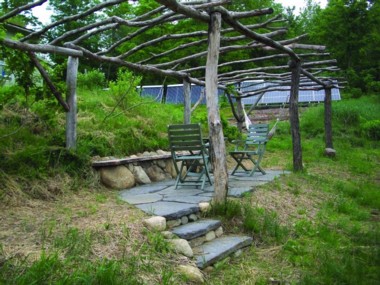The word “sustainability” seems laden with ideals and practicality. But does it make us think about beauty? Aesthetic pleasure? Those notions don’t necessarily spring to mind. Keith Zaltzberg and his associates at Regenerative Design would like to shift any ugly and utilitarian associations all the way to beautiful. The firm’s principals, each with a permaculture background, share a strong mission: to usher sustainable design from the fringe into the mainstream.
While interest in habitat restoration and farming led Zaltzberg to landscape design, his epiphany occurred when he began to appreciate how the shape of everything, from curbs to parking lots to pencils and office chairs, is the result of intentional design. “First,” he says, “I was awestruck by the immense number of hours and sheer creativity poured into our physical world. Second, I was astonished by the amount of shortsightedness and bad design that exists all around us.”
His mission grew clearer: to integrate the needs of people with the benefits and connectivity of healthy ecosystems. His sense of aesthetics grew clearer as well. As he explains, “Our most successful gardens organize natural systems.”
Rather than mimic natural systems, Regenerative Design overlays human eyes and intentions on what appears in nature. “Imagine a tidy, Japanese-style woodland garden with many layers of vegetation, meandering foot paths and idyllic seating,” he says. “And imagine the plants around you are dripping with fruit and nuts, filled with pollinator on fragrant flowers, and packed with potent flavors and medicines. This multisensory, beautiful and functional landscape is the ideal that I work toward.”
Zaltzberg studied at the Conway School of Landscape Design, where he currently teaches digital design. He cites an example of sustainability in action—aesthetically pleasing action—one property over from the school, at Sue Bridge’s Wildside Gardens.
Bridge, the homeowner, asked Regenerative Design to assist her to meet her goal—to demonstrate that sustainable living doesn’t have to be a “mean experience.” Zaltzberg’s interpretation: “She hoped to set an example where comfort and aesthetics can remain striking, whilst hewing to sustainable principles, practices and values.” Bridge moved from Boston to the south-facing hillside and allows Conway School to use her Wildside Gardens for teaching and demonstration purposes.
The features on Bridge’s property are smart. There’s a root cellar and a solar hot water system. There’s a passive solar greenhouse. There are gardens all around the house that produce food for the homeowner and nearby community. But the features are also handsome. The terraces that surround the house extend the usable space in nice weather beyond the house’s footprint. The terraced kitchen gardens beyond, with vegetables, flowers, clover and strawberries, provide bounty and look attractive. Then there’s the planted “green” rooftop on the small, energy-efficient house. The plants up on the roof attract insects and birds. Its marshmallow-like texture atop the house is rather like a whimsical hat you find endearing rather than odd looking.
Well beyond the house is a habitat pond. A boardwalk through the wet meadow allows both people and animals to explore the land. Zaltzberg explains that the purpose of the site is to demonstrate connections between home, garden and habitat. There’s a sense of discovery for visitors navigating the boardwalk as they traverse the property.
Certain plants recur as staple features in edible gardens. Zaltzberg cites bluecrop blueberries (Vaccinium corymbosum, var. “Bluecrop”) as an ecologically smart, adaptable, great-looking and easy-to-grow shrub that “produces heavy crops of big, tasty blueberries, provides forage for native bees, and has brilliant scarlet foliage each fall.” He adds, “It is a perfect productive native replacement for burning bush and barberry.”
Another “tasty” option is Medlar (Mespilius germanica), “a handsome, tough flowering tree in the rose family with dark green tropical-like foliage… Very popular in France and hardy into the northlands of New England, this European tree kicks off the year with a gorgeous display of large white flowers, which over the course of the year transform into russet fruits. Traditionally eaten late in the fall after the fruits have frozen and thawed (a process known as bletting), these little treasures taste like spiced applesauce.”
Paired with aesthetics, no doubt, is the chance to demonstrate how connected ecosystems function, to witness the intricacy firsthand and enjoy bounty and beauty. When Christina Jones, director of Wellesley College’s Botanic Gardens, attended a presentation about edible forest gardens, she approached Zaltzberg afterwards. Swayed by the notion that a garden might showcase more than individual botanical specimens, she wanted to transform a botanical specimens garden into one that demonstrated specimen ecosystems.
The shift resulted in numerous benefits, according to Zaltzberg: “While a botanical specimens garden required a great deal of time, energy and materials, the ecosystems garden would not. Instead, specific plants would be selected to yield food so that visitors could begin to grasp the connections between food, animals and plants.”
Zaltzberg says that Jones’ willingness to innovate at Wellesley’s Botanic Gardens allowed her to develop a cutting edge example of how a low-impact edible forest garden works to employ less human energy and capitalize on natural cycles. The project, led by Dave Jacke, author of Edible Forest Gardens, was “edgy” for an established garden, and generated a great deal of interest and acclaim. It is adjacent to the college’s Observatory. Interested in something “more meaningful” than what had been previously planted in the Observatory’s courtyard, its lead scientist, Richard French, invited Regenerative Design to extend its design work for the Botanic Gardens into the courtyard.
And then they innovated some more. “Using QR codes,” Zaltzberg explains, “the Botanic Garden has a smart phone app so students can go up to a tree and scan the tag. They learn about the nut, the fruit, the medicinal purpose, and collect data about the tree. Citizen scientists employ this technology to add more data for research, and in the process, come to understand nature more deeply and to engage with questions our society faces much differently, too.”•



